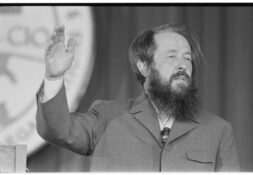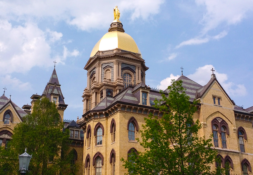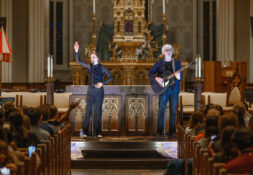Kate Hardiman, Staff Writer
Jordans Speak on Solar Energy During ND Energy Week 2013
Though the leaves are rapidly changing to red and gold, Notre Dame’s campus was awash in green last week for the 7th annual Energy Week. Hosted by Notre Dame’s Center for Sustainable Energy (cSEND), the week raised awareness of the world’s current energy crisis through various events and talks. Notre Dame’s student organization GreeND organized keynote speakers and presentations that explored the topics of solar energy, energy in transportation and energy research internships for students.
Nancy and Bill Jordan, founders of Let’s Share the Sun Foundation, have had a profound impact on the developing world with their innovations in solar energy, and they led a discussion about their work in Haiti. The Jordans both attended Notre Dame, graduating in the class of 1985. Mrs. Jordan began the session with a prayer for the people of Haiti.
The Jordans presented their foundation’s missions to Haiti. “Living in poor areas allowed us to reflect on our faith and help us build community; we knew that the sun could change the world,” they said.
Mr. Jordan discussed the staggering statistic that one third of the world’s population has no electricity.
“With the sunlight that hits the earth in one hour, we could power the world for a year,” he explained. Clearly inspired by the potential of the sun as an unharnessed energy source, the Jordans developed a solution to bring light to Haiti.
Mrs. Jordan spoke of the partnership of Let’s Share the Sun with ND Haiti, ND Alliance for Catholic Education (ACE), Sun Edison, Phocos and many other groups. The Foundation aims to connect with academic institutions and has already installed solar panels on two rural ACE schools in Leogane, Haiti. In the long term, the Jordans hope to demonstrate a replicable model for Haitian rebuilding and bring electricity into individual homes to improve educational opportunities for students and the quality of their family life.
Yet, Mrs. Jordan was adamant about one fact: “The program must be led by Haitians.”
The Jordans are aware of the possible pitfalls of certain strategies for giving advanced energy technology to the developing world. After installation and initial tests, these philanthropists return home, leaving the Haitians without means of perpetuating the energy usage. Counteracting this phenomenon, the Jordans worked hand in hand with the Leogane community to train solar installers, engineers and repairmen who would maintain the solar panels after their departure.
The Jordans’ impact on Haiti has been profound. ACE schools that receive donated computers can put them to use, students can study in the light and small business owners can install refrigeration units and sanitary water systems in schools. During the earthquake, 80 percent of Leogane’s buildings were destroyed. Slowly, with the help of the Jordans, ND Haiti and other philanthropists across the globe, Haiti is rebuilding in a way that will hopefully lead to a better future.
Instrumental in organizing talks such as the Jordans’ has been Barbara Villarosa, the Administrative Services Program Manager of cSEND, who has been involved in Energy Week since its conception in 2007. The cSEND Student Advisory Board takes the lead, and Villarosa acts as a guiding director to ensure that the week runs smoothly. Comprised of undergraduate and graduate students from all colleges on campus, the board invites speakers, plans individual events and promotes the week to the student body.
The first Student Advisory Board was formed in 2007 by 14 enterprising students who sought to raise energy awareness across campus under the direction of Dr. Joan Brennecke, the Keating-Crawford Chair of Chemical and Biomolecular Energy. A tour of the power plant has become a signature event, giving the students a chance to learn where and how their energy on campus is generated. Additionally, students can see the measures the university has taken to reduce its carbon footprint.
Piloting two new events this year, Energy Week boasts a Community Energy Day Tour co-hosted by the Office of Sustainability and the Indiana University South Bend Center for a Sustainable Future. This program expands campus events into the South Bend community, featuring tours to local organizations committed to energy efficiency. Secondly, Innovation Park at Notre Dame sponsored an Energy Start-up Showcase, which invited energy-related companies to share their start-up stories.
The effects of Energy Week permeate student life, and the movement continues to grow. Since 2007, residential dormitories have worked on new energy initiatives each month and have appointed energy commissioners who actively participate in hall council meetings. Dorms spent September, which is energy month, participating in a campus-wide competition to see who could reduce their energy usage through light reduction. Conservation can be as simple as turning off the lights when leaving a room or studying together in a group in the library instead of in dorm rooms.
Shirley Chen, the energy commissioner of Breen-Phillips Hall, encourages her dorm-mates to be conscious of their waste. During lighting month, she encouraged girls to exchange their regular lightbulbs for more efficient CFLs.
“[In order] to get girls interested in saving energy, I like to put up cute animal posters across the dorm to remind them what their energy usage helps when they turn off the lights,” Chen said.
Notre Dame students clearly recognize the need for smarter, more efficient energy use as working toward a sustainable future.
Kate Hardiman is a Freshman living in Breen-Phillips Hall and is ecstatic to be writing her first article for the Rover. She intends to major in the Program of Liberal Studies and possibly double major in business if the world decides PLS will not get her a job. Contact her at khardima@nd.edu.






Leave a Reply